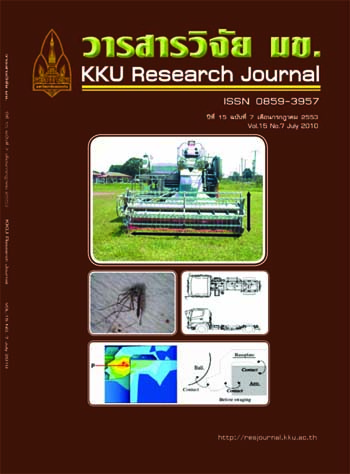Epidemic sources of the causal agent of Pebrine disease from silkworm rearing area (Thai)
Main Article Content
Abstract
Pebrine disease of silkworm (Bombyx mori L.) caused by protozoa, Nosema bombycis N. is the most serious disease, which damages sericultural industry worldwide. Survey and collection of silkworm samples in rearing area of Khon Kaen province from 14 villages, 10 sub-districs, 8 districs were conducted. The collected samples of 106 samples were diagnosed using phase contrast microscopy and found that the infected samples were 19.81%. Four silkworm rearing households of Sok Nok Ten Patana village Moo 7 and Moo 10, Sok Nok Ten Sub-distric, Pol distric, Khon Kaen province were selected as pebrine monitoring representatives for continuously 3 seasons. There were 2 groups to be followed pebrine epidemic by randomized detection of pebrine spores in silkworm samples and rearing appliances. The result revealed that the pebrine spores were not found from silkworm samples and rearing appliances in all 3 seasons of the first group, in which the N. bombycis was not detectable since the beginning of the experiment. However, the pebrine spores were detected in 2nd instar larvae to adults except eggs and 1st instar larvae from the second group which was found the spores of causal agent at beginning of experimented households. Pebrine spores were detected in all rearing members of this group in 3 seasons. Numbers of spores were found additionally more in late period than early period in descending order depended on growth stage. However, in some cases number of spores in pupae was found more than in adults. The average size of oval shape spores was 1.64 - 2.12 x 3.14 - 4.29 µm, with average numbers of 8.46 x 104 - >1.45 x 108 spores/larva. For the rearing appliances: cover cloth, rearing container and mountage, spores were counted in average ratio of 0.05 - 1.85 spores/cm2 and average spore size of 1.57 - 1.95 x 3.10 - 4.07 µm. In case of survey and collection of insects surrounded mulberry orchard of those representative rearing members were also undertaken. There were insects found in total of 21 species of 7 Orders, Coleoptera, Diptera, Hemiptera, Homoptera, Hymenoptera, Odonota and Orthoptera, of which no spores of Nosema spp. were detected in preliminary study. Result of rearing factor relationship on pebrine disease epidemic in this study revealed clearly that positive detection was found consequently in some rearing appliances of silkworm rearing group with positive spore detection at the beginning, while no detection of Nosema bombycis spores was found in the group that negative detection at the beginning in all 3 seasons.


